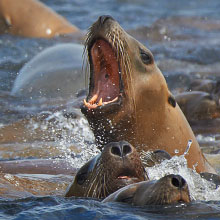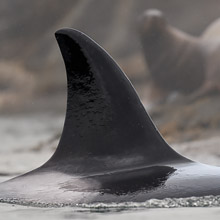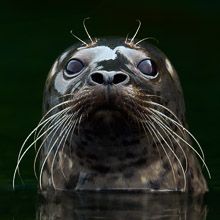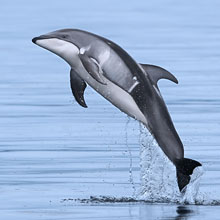Availability: Undetermined - Enquiries?
In the Field
The Return of an Icon. Northern Vancouver Island, BC, Canada. August 12, 2014.
View additional Sea Otter images beginning here: Sea Otters
After a prolonged absence of nearly a century, it's now finally again possible to find sea otters in a few select locations on British Columbia's coast. The playful and almost-always active otters were hunted to extirpation (local extinction) in BC for their luxuriant fur coats by the mid-1800's. But between 1969 and 1972 a total of 89 otters were re-introduced to a few locations on the western coast of Vancouver Island. As one of the rare success stories in conservation, the re-introduced otters have thrived and have spread over the northern tip of Vancouver Island and even over to a few locations on the mainland coast. Baring a catastrophe (such as an oil-spill from a super-tanker), the prospects of continued survival and expansion of the sea otter on BC's coast look good.
Although it's hard to imagine a much simpler (or "stark") image, this one works for me because I think it captures the full serenity and peacefulness of the setting at the time the image was shot. We came across this male otter relaxing on the water's surface on a totally calm and foggy, foggy morning. At the time we were slowly cruising around in a small Zodiac ("trolling" for otters, if you will). Sea otters tend to be on the hyper-active side of the spectrum (they're almost always hunting/eating or tending to the condition of their coat to ensure it maintains its insulating characteristics), but once in a while you can catch one resting on its back or even sleeping. I loved how the fog almost completely removed the background (the faint green zone near the top of the frame is a forest just above the shoreline) and left the otter naturally isolated in the scene. The calm, fog-whitened water also helped simplify the scene and make the otter stand out through natural contrast. And, this is one of the few shots I have of otters where the highly modified rear feet (feet that are "almost flippers") show so well. Classic - and iconic - sea otter!
Sea otters are absolutely unique aquatic mammals. They are the only fully aquatic marine mammals that don't rely on a thick layer of body fat to insulate and protect themselves from the heat-robbing characteristics of the cold-water environment in which they live. Instead, they rely on their high metabolic rate (sustained by the consumption of 23-33% of their body weight in shellfish per day!) and the integrity of their dense coat to maintain their body temperature. This unique approach to thermoregulation in a cold environment has a number of huge ramifications. First, their coats are amazingly dense and luxuriant - they have the highest hair density of any mammal found on earth (approximately 100,000 hairs per square cm!). Simply put, you won't find any other fur that is warmer or "cuddlier". And, the demand for that soft fur drove the relentless hunt for them in the 1700 and 1800's. And, it almost lead to their extinction.
Second, because sea otters require a phenomenal amount of food to maintain their body heat, they both eat a huge amount of shellfish and have a huge ecological effect on the ecosystems in which they are found. One of their preferred foods is sea urchins - and when sea otters are present, sea urchin (and other shellfish) populations are depressed much lower than when sea otters are not present. Because sea urchins in turn eat kelp (lots of kelp - pretty much ALL of it when they are unchecked in numbers!), when urchins are suppressed by sea otters kelp forests absolutely thrive. And, in turn, many species of fish and aquatic vertebrates benefit from the shelter provided by the kelp forests. In areas where sea otters and kelp are found, there is an overall increase of two to five times in the productivity of aquatic invertebrates. Because sea otters have such a disproportionately large impact on the ecosystems in which they are found they are known as "keystone" species.
So all seems rosy with the successful re-introduction of the sea otter to marine ecosystems in BC, right? Well, not to everyone. And, the sea otter story provides an excellent example of yet one more concept - and this time it's one faced by conservation - the shifting baseline concept. In the 100+ years that the sea otter was absent from the BC coast sea urchin and other shellfish populations exploded. This lead to the development of a vibrant shellfish industry that persisted for many decades. During this time you had a few generations of shell-fish dependent humans grow-up in an environment that was devoid of sea otters and, to them, the huge numbers of shellfish just ready to be exploited seemed completely "natural" to them (after all, they had never even seen a sea otter). So, their "baseline" of what seemed normal and natural had shifted to a sea otter-free environment. Add in sea otters now and it's hardly surprising that these folks think of the sea otter as an invasive and dollar-robbing intruder! Being aware of - and appreciating - the reality of the shifting baseline concept can help one see the other side of the argument in some conservation struggles. I suppose whether or not that helps is a different question! ;-)
This is a shot that looks better big (where the detail can be appreciated) So here's a higher resolution (2400 pixel) version of the image for your perusal (enjoy!):
• The Return of an Icon. Download 2400 pixel image (JPEG: 340 KB)
NOTES:
1. This image - in all resolutions - is protected by copyright. I'm fine with personal uses of it (including use as desktop backgrounds or screensavers on your own computer), but unauthorized commercial use of the image is prohibited by law. Thanks in advance for respecting my copyright!
2. Like all wildlife photographs on this website, this image was captured following the strict ethical guidelines described in The Wildlife FIRST! Principles of Photographer Conduct. I encourage all wildlife photographers to always put the welfare of their subjects above the value of their photographs.
3. This image was captured during my "Humpback, Orcas, Sea Lions & More" photo tour in August of 2014. Each year I offer trips into two different parts of the Great Bear Rainforest as well as one to photograph aquatic mammals and oceanscapes near the northern tip of Vancouver Island. And, in selected years, I also offer photo tours to locations to capture other highly sought-after subjects, such as various owl species of the boreal forest and wildlife of Canada's Arctic. Details about these trips can be found on the Photo Tours page of this website.
Behind the Camera
The Return of an Icon. Northern Vancouver Island, BC, Canada. August 12, 2014.
Digital Capture; Compressed RAW (NEF) 14-bit format; ISO 320.
Nikon D4 paired with Nikkor AF-S 80-400mm f4.5-5.6 VR @ 400mm - hand-held from floating Zodiac. VR on in Active mode.
1/800s @ f7.1; +0.33 stop compensation from "recommended" matrix-metered exposure setting.
At the Computer
The Return of an Icon. Northern Vancouver Island, BC, Canada. August 12, 2014.
RAW Conversion to 16-bit TIFF, including first-pass/capture sharpening using Phase One's Capture One Pro. Adjustments made during raw conversion included tweaks to: white balance, levels (slightly redefining both the black and white points), clarity, and a small amount of shadow detail retrieval.
Further digital corrections on resulting 16-bit TIFF files using Adobe's Photoshop CC 2014 and Light Crafts Lightzone. Photoshop adjustments included minor and selective exposure and contrast tweaks, and selective sharpening for web output. Final tweaking of tones performed using LightZone's "tonemapper" tool.
Conservation
The Return of an Icon. Northern Vancouver Island, BC, Canada. August 12, 2014.
Ten percent of the revenue generated by this image will be donated to Raincoast*.
Species Status in Canada**: Special Concern (April 2007) - protected off the North American coast since 1911.
Back in the late 1800's and early 1900's the Sea Otter (Enhydra lutris) was hunted to near extinction along both the Asian and North American Pacific Coasts. The reason? It's luxuriant coat. Otters are unlike any other aquatic mammal in that they don't use fat or blubber to insulate themselves from the chilling effects of the water they are found in. Instead, they rely on their amazingly thick fur coat for insulation. Their amazing coats have a higher density of hair (up to 150,000 strands of hair per square cm!) than any other animal in existence today. To ensure that this coat serves its insulative purpose, otters spend a disproportionately large amount of time grooming their coat (to ensure its natural oils continue to provide an effective waterproof barrier). Unfortunately, the biological functioning of the otters coat can be easily fouled by contamination by oil and other hydrocarbons - thus making them extremely sensitive to the effective of marine oil spills.
Other fascinating aspects of the biology and behaviour of the sea otter include the use of tools (they will use rocks to break apart shellfish such as sea urchins), and the fact that they have an metabolic rate two to three times higher than other mammals of their size. This means they must eat 23% to 33% of their own body weight DAILY, just to to replace the calories burned through maintaining their body temperature in the cold water environment they live in.
*The Raincoast Conservation Society (and Foundation) is an effective and efficient organization that has been fighting for protection of this unique habitat. If you are looking for a meaningful way to contribute to the conservation of this amazing ecosystem, Raincoast will provide maximal "bang" for your conservation dollars.
**as determined by COSEWIC: The Committee on the Status of Endangered Wildlife in Canada























